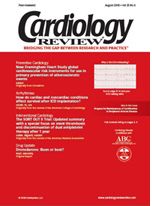Publication
Article
Cardiology Review® Online
Tight glucose control produces long-lasting cardiovascular benefits in type 1 diabetes
Diabetes and cardiovascular disease
San Diego—Intensive blood glucose control for 6 years followed by less intensive control for the next decade reduces the long-term risk of cardiovascular events in patients with type 1 diabetes, said David M. Nathan, MD, at the 65th Annual Scientific Sessions of the American Diabetes Association.
In the Diabetes Complications and Control Trial (DCCT), 1,441 patients aged 13 to 39 years with type 1 diabetes were randomly assigned to intensive management of blood glucose or conventional control. The randomized portion of the trial lasted from 1983 to 1989. Those randomly assigned to intensive control used three or more daily insulin injections or an insulin pump guided by frequent self-monitoring of blood glucose levels to achieve average glycosylated hemoglobin (A1C) levels as close as possible to 6% or less. Conventional treatment consisted of one or two insulin injections per day with daily urine or blood glucose testing.
There was a 2% absolute difference
in mean A1C levels between the two groups, which resulted in a significant reduction in the incidence of retinopathy, neuropathy, and nephropathy in the intensively treated group.
During the 6-year study period, the incidence of cardiovascular events in the intensively treated group was lower than that in the control group (3 versus 14, respectively), but the total number of events was too low to draw any meaningful conclusions, said Dr. Nathan, director of the General Clinical Research Center and the diabetes center at Massachusetts General Hospital, and professor of medicine at Harvard Medical School, Boston.
A1C levels in the two groups drifted together after the original 6 years, to about 8%. Despite this leveling off of A1C levels, the benefits of the original 6 years of intensive control have persisted.
The long-lasting value of intensive control was evident in the difference in the number of cardiovascular events between the two groups over follow-up a decade after the original results were announced. The intensively treated patients had 57% fewer such events compared with the conventionally treated group (46 versus 98, respectively). Thirty-one intensively treated patients and 52 conventionally treated ones had at least one cardiovascular event during the 17 years of follow-up.
The rate of cardiovascular events per 100 patient-years was 0.38 in the intensively treated group and 0.80 in the control group (P = .007). The cumulative rate of cardiovascular events was 6% in the intensively treated group and 11% in the controls, for a 42% reduction (P = .016).
A history of microalbuminuria conferred a 2.9-fold increased risk of cardiovascular events and a history of albuminuria conferred a 2.2-fold increased risk. Adjusting for the difference in microalbuminuria and albuminuria between the two treatment groups explained only a small portion of the treatment effect. “The difference in A1C during DCCT explained 97% of the treatment effect,” said Dr. Nathan. The reduction in cardiovascular events in the intensively treated group “is mediated by changes in glycemia and cannot be entirely explained by kidney disease,” he said.
In another study presented here, Saul Genuth, MD, of Case Western University, Cleveland, said glycation products could explain the “metabolic memory” phenomenon in DCCT. Based on a comparison of skin biopsies in 215 people in each treatment group, researchers found that those who had the highest level of glycation products 10 years ago have had more severe progression of complications, particularly retinopathy and nephropathy, which is strong evidence that those products may be associated with diabetic complications.
